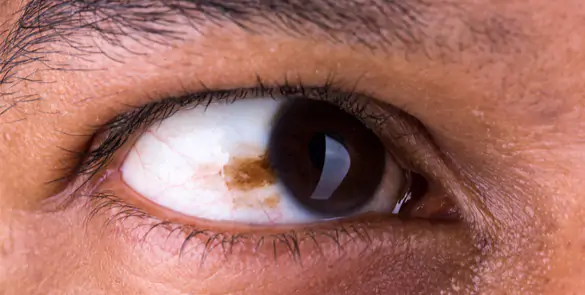
Eye Tumours
This week’s blog on Eye Tumours has been contributed by Dr. Mandeep S. Sagoo, Honorary Consultant Ophthalmologist in Ocular Oncology, oncologist in Dubai, Retino Blastoma and Medical Retina, Moorfields Eye Hospital & Barts Health NHS Trust, London.
Eye Tumours
Tumours inside and on the surface of the eye can be benign or malignant, and can also be primary or secondary tumours. Certain lesions in the eye such as naevi or moles are very common, and usually do not require treatment. Other lesions such as melanoma are rare, and require specialised treatment such as surgery or radiotherapy.
Naevus and Melanoma

Naevus is a benign mole on the eye. Some occur on the surface of the eye, in the conjunctiva, but others are found inside the eye, in the iris, ciliary body or choroid. An optometrist or ophthalmologist often finds these moles inside the eye, during an examination. Most moles should be monitored, although some may require treatment if they are causing vision problems. If moles show any sign of change, such as an increase in size or development of suspicious features, then treatment might be necessary. If they have become malignant – this is usually the diagnosis in adults – many malignant melanomas inside the eye can be treated by radiotherapy. Larger malignant melanomas may require radical surgery, such as removal of the eye.

A Naevus or mole on the surface of the eye. This needs to be monitored.
A melanoma (type of eye cancer) inside the left eye that required treatment with radiotherapy.
Retinoblastoma

This is a childhood cancer of the developing retina and is rare, occurring in approximately 1 in 18,000 live births. It presents with a white-eye pupil reflex or a squint, though there are many other more common causes of these clinical signs. Retinoblastoma can occur in one or both eyes depending on the timing of the genetic mutation that causes tumour formation. Treatment is complex, ranging from chemotherapy to localised treatments such as laser, cryotherapy, localised chemotherapy, radiation, or eye removal.

The white pupil reflex on a photograph from this child’s right eye can be caused by many conditions, but one of the most serious is retinoblastoma, a type of rare eye cancer. Any child with this white reflex should be examined by an ophthalmologist within a week of onset.
A child with multiple retinoblastoma tumours in one eye (arrows). This is a type of eye cancer that requires specialist treatment.
Vascular tumours of the eye
Haemangiomas and vasoproliferative tumours are benign vascular tumours and most are asymptomatic. Some types of vascular tumour can be part of generalised disorders, such as von Hippel Lindau syndrome or Sturge Weber syndrome, but other haemangiomas are not part of a syndrome. The type of treatment depends on the type of lesion and its features, such as the disturbance of surrounding tissues and its potential to cause future problems with sight or the eye. A range of treatments can be used, from laser to photodynamic therapy and radiotherapy.
Other tumours
Other tumours of the eye are very rare. Examples include osteomas, which can cause visual problems. Lymphoma of the eye (primary intraocular or vitreoretinal lymphoma) can affect the vitreous and retina, and usually requires extensive treatment by an oncologist in Dubai. Local treatments with intravitreal methotrexate injections are sometimes necessary to control ocular disease. Choroidal lymphomas may be primary and are often low grade, and usually respond well to radiotherapy treatment.
Secondary tumours
Cancers from other sites in the body can move into the eye. In many cases, the site of the primary cancer is already known but in about one third of cases, the first presentation of the cancer is in the eye itself and an extensive investigation is then required. Treatment would be directed towards the underlying cancer, as well as the eye condition, using radiotherapy, and in some cases local treatment to the eye may be necessary to preserve vision.
Conclusion
In summary, there are many different types of eye tumour occurring in tissues on, around or inside the eye. Many are only found on examination, as they may not cause any symptoms, highlighting the need for appropriate regular check-ups with a consultant (oncologist in Dubai).